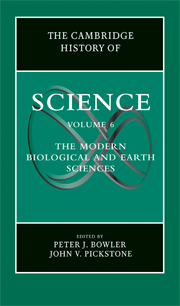Book contents
- Frontmatter
- 1 Introduction
- PART I WORKERS AND PLACES
- PART II ANALYSIS AND EXPERIMENTATION
- 10 Geology
- 11 Paleontology
- 12 Zoology
- 13 Botany
- 14 Evolution
- 15 Anatomy, Histology, and Cytology
- 16 Embryology
- 17 Microbiology
- 18 Physiology
- 19 Pathology
- PART III NEW OBJECTS AND IDEAS
- PART IV SCIENCE AND CULTURE
- Index
- References
11 - Paleontology
from PART II - ANALYSIS AND EXPERIMENTATION
Published online by Cambridge University Press: 28 November 2009
- Frontmatter
- 1 Introduction
- PART I WORKERS AND PLACES
- PART II ANALYSIS AND EXPERIMENTATION
- 10 Geology
- 11 Paleontology
- 12 Zoology
- 13 Botany
- 14 Evolution
- 15 Anatomy, Histology, and Cytology
- 16 Embryology
- 17 Microbiology
- 18 Physiology
- 19 Pathology
- PART III NEW OBJECTS AND IDEAS
- PART IV SCIENCE AND CULTURE
- Index
- References
Summary
The study of paleontology has long provided a rich field for historical analysis. Throughout the nineteenth and twentieth centuries, geologists and paleontologists played prominent, often highly visible roles in science and society, and an earlier generation of scholars devoted considerable attention to such individuals. Biographers, principally scientists, produced laudatory studies of such figures as Georges Cuvier (1769–1832), Roderick Impey Murchison (1792–1871), Richard Owen (1804–1892), and Othniel Charles Marsh (1832–1899). With the development of the history of science as a field in the 1960s and 1970s, scholars devoted their attention to other aspects of the subject. Emphasizing the importance of conceptual and methodological developments in science, historians defined the role that paleontologists had played in documenting the occurrence of extinction, determining the relative age of the earth, and contributing to evolutionary theory.
In more recent years, the increasing interest in understanding science in its social and cultural context has resulted in new and important studies. Focusing on major individuals and developments in the nineteenth century, these contextualized studies challenge the interpretations of an older historiography. In addition to examining the emergence of scientific communities, these analyses illustrate the ways in which social, political, and cultural factors shaped scientific careers and interpretations. The recent interest in scientific practice has fostered analyses of fieldwork and specimen collections. In addition, paleontology has become increasingly important from the perspective of the institutional and disciplinary dimensions of the science. As a field that straddles both the biological and geological sciences, paleontology and its practitioners did not fit easily into the increasingly specialized scientific institutions and infrastructures that began to emerge in the nineteenth century.
- Type
- Chapter
- Information
- The Cambridge History of Science , pp. 185 - 204Publisher: Cambridge University PressPrint publication year: 2009
References
- 1
- Cited by



